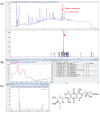Fridamycin A, a Microbial Natural Product, Stimulates Glucose Uptake without Inducing Adipogenesis
- PMID: 30939853
- PMCID: PMC6520714
- DOI: 10.3390/nu11040765
Fridamycin A, a Microbial Natural Product, Stimulates Glucose Uptake without Inducing Adipogenesis
Abstract
Type 2 diabetes is a complex, heterogeneous, and polygenic disease. Currently, available drugs for treating type 2 diabetes predominantly include sulfonylureas, α-glucosidase inhibitors, and biguanides. However, long-term treatment with these therapeutic drugs is often accompanied by undesirable side effects, which have driven interest in the development of more effective and safer antidiabetic agents. To address the urgent need for new chemical solutions, we focused on the analysis of structurally novel and/or biologically new metabolites produced by insect-associated microbes as they have recently been recognized as a rich source of natural products. Comparative LC/MS-based analysis of Actinomadura sp. RB99, isolated from a fungus-growing termite, led to the identification of the type II polyketide synthase-derived fridamycin A. The structure of fridamycin A was confirmed by ¹H NMR data and LC/MS analysis. The natural microbial product, fridamycin A, was examined for its antidiabetic properties in 3T3-L1 adipocytes, which demonstrated that fridamycin A induced glucose uptake in 3T3-L1 cells by activating the AMP-activated protein kinase (AMPK) signaling pathway but did not affect adipocyte differentiation, suggesting that the glucose uptake took place through activation of the AMPK signaling pathway without inducing adipogenesis. Our results suggest that fridamycin A has potential to induce fewer side effects such as weight gain compared to rosiglitazone, a commonly used antidiabetic drug, and that fridamycin A could be a novel potential therapeutic candidate for the management of type 2 diabetes.
Keywords: 3T3-L1 cells; Actinomadura sp. RB99; fridamycin A; glucose uptake; type 2 diabetes.
Conflict of interest statement
The authors declare no conflict of interest.
Figures



References
-
- Liu Z.Q., Liu T., Chen C., Li M.Y., Wang Z.Y., Chen R.S., Wei G.X., Wang X.Y., Luo D.Q. Fumosorinone, a novel PTP1B inhibitor, activates insulin signaling in insulin-resistance HepG2 cells and shows anti-diabetic effect in diabetic KKAy mice. Toxicol. Appl. Pharmacol. 2015;285:61–70. doi: 10.1016/j.taap.2015.03.011. - DOI - PubMed
-
- Eid H.M., Thong F., Nachar A., Haddad P.S. Caffeic acid methyl and ethyl esters exert potential antidiabetic effects on glucose and lipid metabolism in cultured murine insulin-sensitive cells through mechanisms implicating activation of AMPK. Pharm. Biol. 2017;55:2026–2034. doi: 10.1080/13880209.2017.1345952. - DOI - PMC - PubMed
MeSH terms
Substances
Grants and funding
LinkOut - more resources
Full Text Sources
Medical

